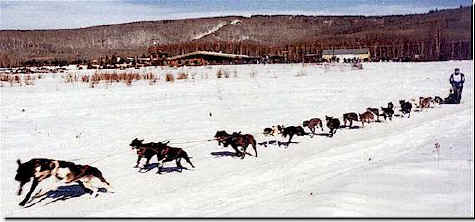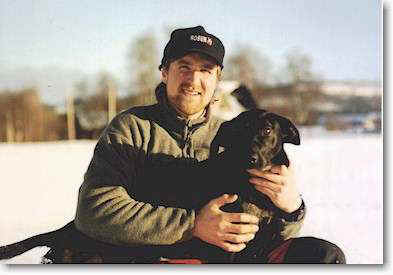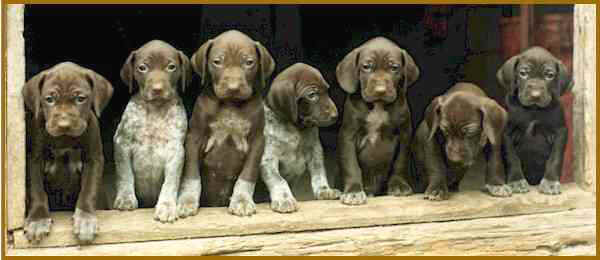Meet Egil Ellis
Exceptional "Scandinavian Hound" Racer

Part 1

Egil & his team at the 1998 Open North American
Championship,
Fairbanks, Alaska
Name:
Kennel Name:
Birthplace:
Home Town:
Occupation:
Web Site: |
Egil Ellis
Ellis Racing Sleddogs
Sweden
Willow, Alaska, USA
Professional Dog Musher
Egil's Facebook Page |
I was born 1970 in Funåsdalen, northern Sweden and since 1991 I live
together with Helen Lundberg in Borås, southern part of Sweden. I have been involved with
sled dogs since I was 12 years old. Since I finished school everything has circled around
sled dogs and for the last 8 years I have been a professional dog musher.
How long have you been involved with sled dogs?
My father, Bengt Ellis, was one of the first who started running dogs in
Scandinavia, back in the late 1940’s. He introduced me into the sport when we came
back to Sweden after two years stay British Columbia, Canada. My brother and I got one
Siberian Husky puppy each for a Christmas present. That was in 1982.
If you remember your very first time behind a team of dogs, tell us about it.
First time behind a sled was with our two Siberian Husky puppies on bare ground
with a homemade sled running behind me and my brother.
What is your primary sled dog activity or area of interest?
I have been racing open class sprint for the last 10 years winning the European
Championships 1996 and 1997, Silver Medal at the IFSS World Championship in Finland 1997.
I also won the IFSS World Cup series open class 1996. For the last 7 years I am also the
Swedish Champion in open class. This year 1998, was our first year racing in Alaska with a
fifth place finish in Open North American Championships and a first place in Tok Race of
Champions.
What size kennel do you operate?
Just now, August 1998, we have 90 adults and about 30 puppies in the kennel. The
grown up dogs are chained to a pole with a swivel in it. Each of the chained dogs are
standing on 4 x 4 meter wooden platforms. They each have an isolated doghouse with plenty
of clean, fresh straw, year around. [Photo of kennel
setup.]
The puppies stay in large pens and every day they spend several hours in a big fenced
area, playing with each other.
Give us an overview of your feeding program.
We feed a Swedish made dry dog food, that is called Robur Tribute. It is a high
premium dog food made out of fresh chicken meat. To this we ad about 20-40% of a meat mix
consisting of chicken, beef, pork, liver and salmon. Extra fat is also added during the
cold winter months.
What advice would you give a beginning musher?
Number one, you must love dogs.
- It’s good if you have an idea of where you want to end up--if you want to win the
World Championship in sprint, the Iditarod, or just tour around in the mountains.
- Buy dogs from proven kennels that have been on top level racing for many years.
- Ask a lot of questions to experienced mushers. That way you will avoid many stupid
mistakes.
- Visit different kennels and you will see a lot of different setups. Take the parts you
like best from each and build your own kennel.
- Don’t rush into the sport and start out with more dogs than you can handle. It is
better to spend more time on less dogs.
- If you want to reach the top be prepared for years of hard work and to spend lots of
money.
What breed(s) do you work with?
For the last 10 years we have developed our own breed of dogs. They are a
crossbreed between Alaskan Husky and german or english shorthaired pointer. We have
selected dogs for open class sprint racing and we are coming close to a type of dog that
we hope, in a few years, will burn up the Alaskan trails!
In Sweden it has been a long tradition to race with german and english shorthaired
pointers. These dogs have been bred for this purpose the last 50 years. They have an
enormous working attitude and are extremely tough on themselves under hard conditions
working in a team. Today you can see a lot of limited class teams that are made up of
purebred english and german shorthaired pointers.
In the 80's there were a lot of good Alaskan Huskies imported to Sweden and Norway. But
a lot of the top mushers realized that if they one day would be able to beat the best
Alaskan teams, they must come up with something new, something that the mushers
didn’t have in Alaska.
We couldn’t breed better dogs than what they already had in Alaska, with the
selected dogs that were imported to Sweden and Norway. So this is where the sled dog bred
pointers came in handy. We crossed the best german and english shorthaired pointers with
the best of the imported Alaskan Husky lines and got a new type of sled dog, the Scandinavian
Hound! [Photo of Egil and his team winning the
1998 World Cup race in Ostersund, Sweden, 1998]
What physical characteristics do you look for in your dogs?
The pointers are originally bred for hunting in the mountains. They have an
enormous stamina and endurance, running for a whole day during hunting is no problem. The
individuals we use for crossbreeding are small, light boned and mentally very stable, in
comparison with the bigger, heavier type (30-40 kg.) used for pulka racing. Our pointers
and most of our crossbreeds have a weight of 18-24 kilos.
What mental or emotional attributes do you require in your dogs?
When crossbreeding two totally unrelated types of dogs you seem to get a
fantastic outcross effect--a hybrid:
- Very sound dogs with tough, stable mentality.
- An enormous working attitude, that sometimes can be hard to curb.
- Very eager to please, when taught something they will do everything for you.
- Extremely friendly and social, makes great pets also.
- They eat everything, and need a lot more food than the average Alaskan Husky especially
in the winter because of their short coats and high metabolism.
- They need more maintenance in the winter: Isolated doghouses, lots of straw, tit guards
on females that have had puppies when it is really cold.
- Our purebred pointers, that have no coat at all, live in a dog barn during the winter
and stay home from training when it is below -25C.

Egil & Mike
Tell us about an all time favorite dog or two:
My favorite dog so far is my main leader, MIKE. He is fast as Michael Johnson,
strong as Mike Tyson and can jump like Michael Jordan!
Ever since Mike was a little puppy he has been special. We could see it at an early age
that this was going to be a super leader: he wasn’t afraid of anything, he was always
running in front of the other puppies and at the same time extremely focused on us. Mike
is a big dog, 26 kg and 72 cm high. His body is hard as a rock.
Mike's characteristics in the team is that he starts out slowly and sometimes
carefully. It takes him about 3-4 km to get warmed up. But the farther you go and the
closer you get to the finish, the harder he drives. Sometimes the rest of the team dogs
are hanging by the neckline when he sprints to the finish line.

German Shorthair Puppies
What criteria do you use for selecting breeding stock?
When we select dogs to breed with, they must have proved their qualities in the team,
preferably during many years. We try only to breed with leaders, because it is one of the
qualities that is easily lost in a breeding program.
Do you use any pre-training evaluation of puppies?
The pre-training evaluation of the puppies consist of long walks with them in the forest.
There we can see what attitude they have towards running in a group and staying up front.
They learn to handle their bodies at high speeds, jump over logs, crossing open water and
staying close to us. We often take them on rides in the dog truck so they are ready for
traveling in the fall. [Photo of Lingon, summer 98 puppy,
50% hound, 50% husky]
What method do you use for starting pups?
Before we harness break puppies at 6 month of age, we teach them to be tied up on a chain.
This teaches them to be tied up and they also learn how to untangle themselves. They get
their own house and 2 meter long chain where they stay for 2-3 weeks. During this time we
limit the amount of free running that they are used to. After this period we take two
grown up leaders and 4 puppies and go! The last years we have harness broken all puppies
at our winter camp, so they can run on snow. Another good method is to teach them to chase
the snowmachine when they are loose. Then when you harness break them you run the
snowmachine in front of the team and they automatically start to chase the snowmachine and
forget about all the lines and harnesses.
At what point do you decide a pup is likely to make it in your team?
We treat all puppies equal. They all get the same training and chance to prove themselves.
Usually the big, heavy males are better suited for limited class racing but there we have
Mike as an exception to that rule!
 More photos of Egil's dogs and kennel More photos of Egil's dogs and kennel 

Part 2
Training & Racing, The Future & more

Egil's Facebook Page
[back to Interview list]

top of page |
home |
feedback | search

|



